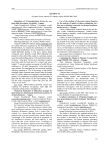Статьи журнала - Компьютерная оптика
Все статьи: 2511

A solution method for image distortion correction model based on bilinear interpolation
Статья научная
In the process of the image generation, because the imaging system itself has differences in terms of nonlinear or cameraman perspective, the generated image will face the geometric distortion. Image distortion in general is also a kind of image degradation, which needs the geometric transform to correct each pixel position of the distorted images, so as to regain the original spatial relationships between pixels and the original grey value relation, and which is also one of important steps of image processing. From the point of view of the digital image processing, the distortion correction is actually a process of image restoration for a degraded image. In image processing, in terms of the image quality improvement and correction technology, namely the image restoration, with the wide expansion of digital image distortion correction processing applied, the processing technology of the image restoration has also become a research hotspot. In view of the image distortion issue, this paper puts forward the image distortion correction algorithm based on two-step and one-dimensional linear gray level interpolation to reduce the computation complexity of the bilinear interpolation method, and divide the distorted image into multiple quadrilaterals, and the area of the quadrilateral is associated with the distortion degree of the image in the given region, and express the region distortion of each quadrilateral with the bilinear model, thus determining parameters of bilinear model according to the position of the quadrilateral vertex in the target image and the distorted image...
Бесплатно
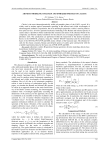
Ab initio modeling of Raman and infrared spectra of calcite
Статья научная
Calcite is the most thermodynamically stable polymorphic phase of the CaCO3 crystal. It is widely used in modern optical instruments operating in the infrared and visible wavelengths of electromagnetic radiation. In particular, due to its anisotropic properties, calcite is used in polarization optics devices. Ab initio quantum mechanical modeling of the Raman and infrared spectra of calcite makes it possible to better understand the structure and nature of the chemical bonds of the compound, and find the optimal conditions for the effective use of unique properties of calcite in photonics tools. The calculations are performed within the framework of the density functional theory in the CRYSTAL program, using the “hybrid” B3LYP functional and the all-electronic bases of the STO-6G, PO-TZVP and BSD atomic orbitals of the Gaussian type. The obtained results for the elastic constants, Raman and infrared spectra of calcite agree satisfactorily with the available experimental data for the basic sets of POB-TZVP and BSD.
Бесплатно
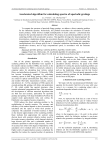
Accelerated algorithm for calculating spectra of aperiodic gratings
Статья научная
To compute the spectrum of aperiodic Bragg gratings, we address a direct scattering problem for the Helmholtz equation. Numerically, this problem necessitates the calculation of transfer matrix products, which involves multiple multiplications of matrix elements – polynomials that depend on the spectral parameter of the problem. We propose an accelerated algorithm to solve the scattering problem with second-order accuracy. This algorithm leverages the integral approach for discretization, a duplication strategy, the convolution theorem, and the fast Fourier transform. The computational complexity of this approach is asymptotically O(N log2N) arithmetic operations (multiplications) for a discrete grid of size N. Numerical simulations corroborate the algorithm’s second-order accuracy and its high computational speed, in accordance with the estimates obtained.
Бесплатно
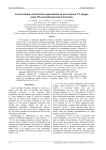
Статья научная
In this paper, an automatic algorithm aimed at volumetric segmentation of acute ischemic stroke lesion in non-contrast computed tomography brain 3D images is proposed. Our deep-learning approach is based on the popular 3D U-Net convolutional neural network architecture, which was modified by adding the squeeze-and-excitation blocks and residual connections. Robust pre-processing methods were implemented to improve the segmentation accuracy. Moreover, a special patches sampling strategy was used to address the large size of medical images and class imbalance and to stabilize neural network training. All experiments were performed using five-fold cross-validation on the dataset containing non-contrast computed tomography volumetric brain scans of 81 patients diagnosed with acute ischemic stroke. Two radiology experts manually segmented images independently and then verified the labeling results for inconsistencies. The quantitative results of the proposed algorithm and obtained segmentation were measured by the Dice similarity coefficient, sensitivity, specificity and precision metrics. The suggested pipeline provides a Dice improvement of 12.0 %, sensitivity of 10.2 % and precision 10.0 % over the baseline and achieves an average Dice of 62.8 ± 3.3 %, sensitivity of 69.9 ± 3.9 %, specificity of 99.7 ± 0.2 % and precision of 61.9 ± 3.6 %, showing promising segmentation results.
Бесплатно
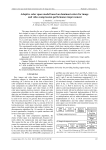
Статья научная
This paper describes the use of some color spaces in JPEG image compression algorithm and their impact in terms of image quality and compression ratio, and then proposes adaptive color space models (ACSM) to improve the performance of lossy image compression algorithm. The proposed ACSM consists of, dominant color analysis algorithm and YCoCg color space family. The YCoCg color space family is composed of three color spaces, which are YCcCr, YCpCg and YCyCb . The dominant colors analysis algorithm is developed which enables to automatically select one of the three color space models based on the suitability of the dominant colors contained in an image. The experimental results using sixty test images, which have varying colors, shapes and textures, show that the proposed adaptive color space model provides improved performance of 3 % to 10 % better than YCbCr, YDbDr, YCoCg and YCgCo-R color spaces family. In addition, the YCoCg color space family is a discrete transformation so its digital electronic implementation requires only two adders and two subtractors, both for forward and inverse conversions.
Бесплатно
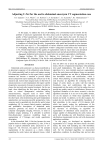
Adjusting U-net for the aortic abdominal aneurysm CT segmentation case
Статья научная
In this paper, we address the issue of developing of a convolutional neural network for the problem of aneurysm segmentation into three classes and of exploring ways for improving the quality of final segmentation masks. As a result of our study, macro dice score for classes of interest reaches 83.12% ± 4.27%. We explored different augmentation styles and showed the importance of applying intensity augmentation style to improve segmentation algorithm robustness in conditions of clinical data diversity. Augmentation with spatial and insensitive styles increase macro dice score up to 3%. The comparison of various inference mode indicate that combination of overlapping inference and segmentation window enlargement ameliorate macro dice up to 1.4%. Overall improvement of the quality of segmentation masks by macro dice score amounted up to 6% using combination of data-based augmentation style and advanced inference technique.
Бесплатно
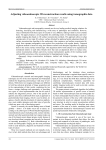
Adjusting videoendoscopic 3D reconstruction results using tomographic data
Статья научная
Videoendoscopic and tomographic research are the two leading medical imaging solutions for detecting, classifying and characterizing a wide array of pathologies and conditions. However, source information from these types of research is very different, making it hard to cross-correlate them. The paper proposes a novel algorithm for combining results of videoendoscopic and tomographic imaging data based on 3D surface reconstruction methods. This approach allows to align separate parts of two input 3D surfaces: surface obtained by applying bundle adjustment-based 3D surface reconstruction algorithm to the endoscopic video sequence, and surface reconstructed directly from separate tomographic cross-section slice projections with regular density. Proposed alignment method is based on using local feature extractor and descriptor algorithms by applying them to the source surface normal maps. This alignment allows both surfaces to be equalized and normalized relative to each other. Results show that such an adjustment allows to reduce noise, correct reconstruction artifacts and errors, increase representative quality of the resulting model and establish correctness of the reconstruction for hyperparameter tuning.
Бесплатно
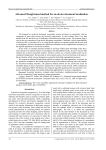
Advanced Hough-based method for on-device document localization
Статья научная
The demand for on-device document recognition systems increases in conjunction with the emergence of more strict privacy and security requirements. In such systems, there is no data transfer from the end device to a third-party information processing servers. The response time is vital to the user experience of on-device document recognition. Combined with the unavailability of discrete GPUs, powerful CPUs, or a large RAM capacity on consumer-grade end devices such as smartphones, the time limitations put significant constraints on the computational complexity of the applied algorithms for on-device execution. In this work, we consider document location in an image without prior knowledge of the document content or its internal structure. In accordance with the published works, at least 5 systems offer solutions for on-device document location. All these systems use a location method which can be considered Hough-based. The precision of such systems seems to be lower than that of the state-of-the-art solutions which were not designed to account for the limited computational resources. We propose an advanced Hough-based method. In contrast with other approaches, it accounts for the geometric invariants of the central projection model and combines both edge and color features for document boundary detection. The proposed method allowed for the second best result for SmartDoc dataset in terms of precision, surpassed by U-net like neural network. When evaluated on a more challenging MIDV-500 dataset, the proposed algorithm guaranteed the best precision compared to published methods. Our method retained the applicability to on-device computations.
Бесплатно
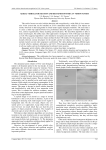
Aerial vehicles detection and recognition for UAV vision system
Статья научная
This article focuses on aerial vehicle detection and recognition by a wide field of view monocular vision system that can be installed on UAVs (unmanned aerial vehicles). The objects are mostly observed on the background of clouds under regular daylight conditions. The main idea is to create a multi-step approach based on a preliminary detection, regions of interest (ROI) selection, contour segmentation, object matching and localization. The described algorithm is able to detect small targets, but unlike many other approaches is designed to work with large-scale objects as well. The suggested algorithm is also intended to recognize and track the aerial vehicles of specific kind using a set of reference objects defined by their 3D models. For that purpose a computationally efficient contour descriptor for the models and the test objects is calculated. An experimental research on real video sequences is performed. The video database contains different types of aerial vehicles: airplanes, helicopters, and UAVs. The proposed approach shows good accuracy in all case studies and can be implemented in onboard vision systems.
Бесплатно
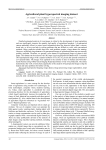
Agricultural plant hyperspectral imaging dataset
Статья научная
Detailed automated analysis of crop images is critical to the development of smart agriculture and can significantly improve the quantity and quality of agricultural products. A hyperspectral camera potentially allows to extract more information about the observed object than a conventional one, so its use can help in solving problems that are difficult to solve with conventional methods. Often, predictive models that solve such problems require a large dataset for training. However, sufficiently large datasets of hyperspectral images of agricultural plants are not currently publicly available. Therefore, we present a new dataset of hyperspectral images of plants in this paper. This dataset can be accessed via URL https://pypi.org/project/HSI-Dataset-API/. It contains 385 hyperspectral images with a spatial resolution of 512 by 512 pixels and spectral resolution of 237 spectral bands. The images were captured in the summer of 2021 in Samara and Novocherkassk (Russia) using Offner based Imaging Hyperspectrometer of our own production. The article demonstrates the work of some basic approaches to the analysis of hyperspectral images using the dataset and states problems for further solving.
Бесплатно
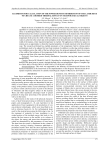
Статья научная
Based on the use of methods for solving the inverse problem of heat conduction, we developed an algorithm for calculating the power density distribution of the laser beam to create a desired thermal effect on technological objects. It was shown that the redistribution of power density of moving distributed surface heat sources can adjust the temperature distribution in the treated zone. The results of thermal processes calculation show the ability of the developed algorithm to create a more uniform temperature field across the width of the heat affected zone. Equalization of maximum temperature values is achieved in the center and on the periphery of the heat affected zone with an increase in the width of the regions, where required temperature is reached. The application of diffractive optical elements gives an opportunity to obtain the required properties of treated materials in the heat affected zone. The research performed has enabled parameters of the temperature field in chrome-nickel-molybdenum steel to be adjusted for laser heat treatment. In addition to achieving uniform temperature conditions across the width of the heat affected zone, the proposed approach allows the increase of the width of the isotherms of the temperature fields; this provides an opportunity to process a larger area per unit time at the same laser beam power.
Бесплатно
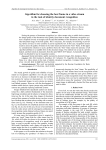
Algorithm for choosing the best frame in a video stream in the task of identity document recognition
Статья
During the process of document recognition in a video stream using a mobile device camera, the image quality of the document varies greatly from frame to frame. Sometimes recognition system is required not only to recognize all the specified attributes of the document, but also to select final document image of the best quality. This is necessary, for example, for archiving or providing various services; in some countries it can be required by law. In this case, recognition system needs to assess the quality of frames in the video stream and choose the "best" frame. In this paper we considered the solution to such a problem where the "best" frame means the presence of all specified attributes in a readable form in the document image. The method was set up on a private dataset, and then tested on documents from the open MIDV-2019 dataset. A practically applicable result was obtained for use in recognition systems.
Бесплатно
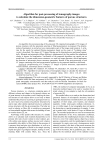
Статья
An algorithm for post-processing of the grayscale 3D computed tomography (CT) images of porous structures with the automatic selection of filtering parameters is proposed. The determination of parameters is carried out on a representative part of the image under analysis. A criterion for the search for optimal filtering parameters based on the count of "levitating stone" voxels is described. The stages of CT image filtering and its binarization are performed sequentially. Bilateral and anisotropic diffuse filtering is implemented; the Otsu method for unbalanced classes is chosen for binarization. Verification of the proposed algorithm was carried out on model data. To create model porous structures, we used our image generator, which implements the function of anisotropic porous structures generation. Results of the post-processing of real CT images containing noise and reconstruction artifacts by the proposed method are discussed.
Бесплатно
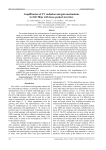
Amplification of UV radiation and gain mechanisms in ZnO films with loose-packed structure
Статья научная
The modern demands for miniaturization of optoelectronic devices, in particular, for the UV range, are inextricably linked with the improvement of fabrication technologies for the corresponding photonic nano/micro objects and the study of their radiative properties. In this work, the method of pyrolytic carbothermal synthesis, which is a modification of the thermal evaporation method, was used to fabricate microcrystalline ZnO films with laser properties. The influence of the size and packing type of ZnO microcrystallites in the films on their emissive properties were revealed. The films with relatively large microcrystallites (10–15 µm in size on average) were found to exhibit UV amplified spontaneous emission at room temperature. The possibility of additional enhancement of this emission and its two-threshold behavior in loose-packed regions of such films were found for the first time. It was shown that the observed phenomenon is due to the competition between two gain mechanisms, which are assumed to arise predominantly in different regions of microcrystallites as a result of exciton-phonon and exciton-electron interaction processes. As the temperature decreases, the dominant gain mechanism gradually changes to exciton-exciton scattering, regardless of the type of film structure. The results obtained open up the possibilities of the thermal evaporation synthesis to a wider extent and can be useful in interpreting the optical gain mechanisms in ZnO micro- and nanostructures.
Бесплатно
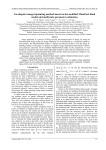
Статья научная
Image inpainting is a process of filling missing and damaged parts of image. By using the Mumford-Shah image model, the image inpainting can be formulated as a constrained optimization problem. The Mumford-Shah model is a famous and effective model to solve the image inpainting problem. In this paper, we propose an adaptive image inpainting method based on multiscale parameter estimation for the modified Mumford-Shah model. In the experiments, we will handle the comparison with other similar inpainting methods to prove that the combination of classic model such the modified Mumford-Shah model and the multiscale parameter estimation is an effective method to solve the inpainting problem.
Бесплатно
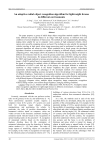
An adaptive radial object recognition algorithm for lightweight drones in different environments
Статья научная
The paper proposes a group of radial shape object recognition methods capable of finding many different-sized circular objects in an image with high accuracy in minimum time and conditions of uneven brightness of frame areas. The methods are not computationally demanding, making them suitable for use in computer vision systems of light unmanned vehicles, which cannot carry powerful computing devices on board. The methods are also suitable for unmanned vehicles traveling at high speed, where image processing must be performed in real-time. The proposed algorithms are robust to noise. When combined into a single group, the developed algorithms constitute a customizable set capable of adapting to different imaging conditions and computing power. This property allows the method to be used for detecting objects of interest in different environments: from the air, from the ground, underwater, and when moving the vehicle between these environments. We proposed three methods: a hybrid FRODAS method combines the FRST and Hough methods to increase accuracy and reduce the time to search for circles in the image; a PaRCIS method based on sequential image compression and reconstruction to increase the speed of searching for multiple circles of different radii and removing noise; an additional modification of LIPIS is used with any of the primary or developed methods to reduce the sensitivity to sharp variations in the frame's brightness. The paper presents comparative experiments demonstrating the advantages of the developed methods over classical circle recognition methods regarding accuracy and speed. It shows the advantage of recognizing circles of different brightness. Experiments on recognizing multiple real-world objects in photographs taken on the ground, in the air, and underwater, with complex scenes under distortion and blurring with different degrees of illumination, demonstrate the effectiveness of the set of methods.
Бесплатно
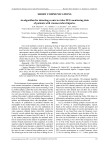
Статья научная
One of the problems solved by analyzing the data of long-term Video EEG monitoring is the differentiation of epileptic and artifact events. For this, not only multichannel EEG signals are used, but also video data analysis, since traditional methods based on the analysis of EEG wavelet spectrograms cannot reliably distinguish an epileptic seizure from a chewing artifact. In this paper, we propose an algorithm for detecting artifact events based on a joint analysis of the level of the optical flow and the ridges of wavelet spectrograms. The preliminary results of the analysis of real clinical data are given. The results show the possibility in principle of reliable distinguishing non-epileptic events from epileptic seizures.
Бесплатно
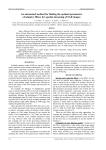
Статья научная
Many different filters can be used to reduce multiplicative speckle noise on radar images. Most of these filters have some parameters whose values influence the result of filtering. Finding optimal values of such parameters may be a non-trivial task. In this paper, a formal automated method for finding optimal parameters of speckle noise reduction filters is proposed. Using a specially designed test image, optimal parameters for the most commonly used filters were found using several image quality assessment metrics, including the Structural Similarity Index (SSIM) and Gradient Magnitude Similarity Deviation (GMSD). The use of filters with optimal parameters allows processing (detection, segmentation, etc.) of radar images with minimal influence of speckle noise.
Бесплатно
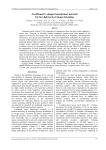
An efficient U-shaped transformer network for low-light power image denoising
Статья научная
Unmanned aerial vehicle (UAV) inspection of transmission lines has been widely applied in recent years. However, in low-light weather conditions, random noise often appears in the captured transmission line images due to the combined effects of brightness, electromagnetic interference, and camera sensor limitations. This noise significantly undermines the quality and accuracy of the inspection. To address this challenge, we propose a novel transformer-based image denoising method called EUformer. First, we propose the Global Feature Compensator (GFC) module, which adaptively captures remote pixel dependencies for improved global image modelling. Second, we designed the Mixed-Gated feed-forward network (MG-FFN), to enhance the aggregation of local contextual information. Finally, the loss function is optimized by introducing a new regular term, effectively addressing negative effects such as artefacts in the reconstructed images. To assess the denoising capabilities of the EUformer model proposed in this study for transmission line images, we developed a benchmark dataset specifically for low-light transmission line image denoising. The results of extensive experiments demonstrate that the EUformer model achieves competitive performance while maintaining low complexity.
Бесплатно

